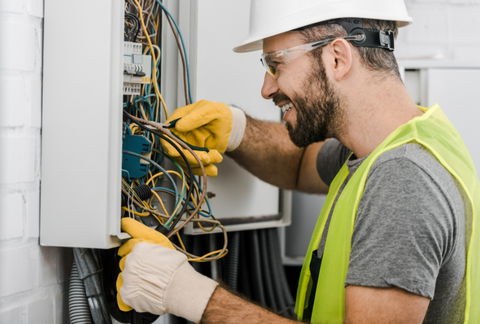When protecting valuable components from harmful environments, one of the biggest threats is impacts that break or damage the enclosure. If an enclosure cannot withstand the damage the impact has caused, it will eventually cause malfunction of the product.

When choosing a protective enclosing solution, it is necessary that you understand the operating principles of the equipment that will be installed in the enclosure, as well as the conditions in which the equipment will operate.
As a designer, it is important to decide on the appropriate enclosure for your needs in order to avoid extra cost or work in later stages. Therefore, choosing a right enclosure early on in the designing project can save in design cost and product assembly time, while at the same time reduce product failures and claims.
With the following information, we guide you how to choose an industrial enclosure in the smartest way possible when impact rating and durability are priority.
What does IK-rating mean?
IK-rating is a number from IK00 to IK10, which tells how well products withstand impacts and hits. The higher the IK-rating is the better impact resistance it has.
Typically, industrial grade enclosures require IK-rating from IK06 up to IK10. For industrial enclosures, third party impact test conditions are conducted both in -25C and +35 Celsius temperatures. This means that the product is suitable for both hot and cold climates. For plastic enclosures, the cold temperatures are more challenging as the material will become more brittle. There are aging tests conducted for the enclosure to simulate environmental conditions and then the enclosure is targeted with impacts based on the wanted IK-rating. After the targeted hits, the enclosure needs to function as it is supposed to.
Laboratory IK-rating is a very good indication of the enclosures durability. However real life conditions and requirements can differ from the tests conducted. Therefore, it is good to understand the conditions where the product is used in order to find the best possible solution with a long lifetime.
How does enclosure manufacturers improve IK-rating?
Enclosure manufacturers' main ways for improving enclosure's impact rating includes the following:
- Material - Choosing material, which has great properties against impacts
- Thickness - Increase material thickness of the enclosure
- Shape - Design the enclosure shape so that it deflects impacts or disperses the impact energy to a wide area
- Low IP-rating - Applying lower IP or Nema rating allows the enclosure to deform more during the impacts and still pass the tests.
IK-rating is an easy number for consultants and designers to specify industrial enclosure. This drives enclosure manufacturer to aim for higher IK-rating. For higher IK-rating, you normally need to make some compromises: Either have a higher price for the enclosure due to better raw material, or lower IP-rating.
Raw material is the single most important factor, when aiming for high IK10-rated enclosures. The best three enclosure materials are stainless steel, glass reinforced polyester and polycarbonate. Stainless steel is the most expensive material, but has best impact resistance. Glass reinforces polyester is extremely strong, but prone to UV radiation and is non-recyclable. Latest technological advances have allowed polycarbonate to join this group as well. Polycarbonate is UV-resistant, non-corrosive material which can be recycled. Typically, a thicker enclosure wall improves the durability of the enclosure, but this varies by material.
The shape of the enclosure is an important aspect when trying to achieve an IK10-rated enclosure. The corners are usually the weak points. Therefore, round shapes allow impact energy to be deflected from energy or dispersed to larger area. An round shaped enclosure typically has better chances withstanding the impacts than a similar enclosure with sharp corners.
It is easier to achieve an IK10 enclosure, which is rated IP55 than an IK10 enclosure that is rated IP66. Therefore, if an enclosure is rated IP66 or even IP68 and has also a IK10-rating, it means that it doesn't deform at all or very little during the impacts. As all the test enclosures go through the IP- testing after the hits, a lower IP-rated enclosure can pass the test even if it would leak or break apart. This is good to keep in mind when searching for very durable enclosures, even though this should be used as supportive information.
Things that lower the impact resistance of the enclosure over time
There are three main factors that reduce the enclosure impact resistance and durability over time:
- UV-radiation
- Corrosive environments
- Chemicals
When years go by, the enclosure loses its impact resistance properties, if the environment is hostile for the particular raw material. Typically, UV-radiation makes the plastic material yellow, brittle and soft. Some plastics such as high-quality polycarbonate are almost unaffected, if right additives are used. Also steel and stainless steel enclosures are totally unaffected by the UV-radiation.
Corrosive environments are the biggest challenge for metal and sometimes even stainless steel. Even if the steel enclosure is galvanized or painted, there can be scratches and dents on the enclosure. Impacts and scratches may have stripped the protective paint or zinc layer off. Thus, corrosion can start and damage the enclosure. Plastic materials are non-corrosive and are therefore a not affected by corrosive soil or sea areas where salt is present.
Chemical resistance of the enclosure depends on the material used. As there is a very wide range of chemicals, you should check enclosure suitability for the particular chemical. All the enclosure raw materials have weaknesses to certain chemicals. For example, stainless steel is weak to chlorine ions that basically all the salts have. Polycarbonate on the other hand is weak to some solvents. Please keep in mind that enclosures can have other visible parts that are not made out of the same raw material. For example, cover screws, cable glands and inspection windows can be of different material and these should also be suitable for the environment you are going to use the enclosures in.
Conclusion
There are uses for high IK-rated enclosures, but not everyone needs them. However, if you do need durable and high impact resistance enclosures make sure you analyse all the properties of the enclosure, not just the IK-rating.
In order to have the best Quality/Cost ratio for your enclosure, you need to understand the environment where the final product and internal components inside the enclosure are used. This way you can choose an enclosure that is durable, a long lifetime product that protect your electrical product and save money at the same time. Choose smartly!
For more information, please contact www.fibox.com.
